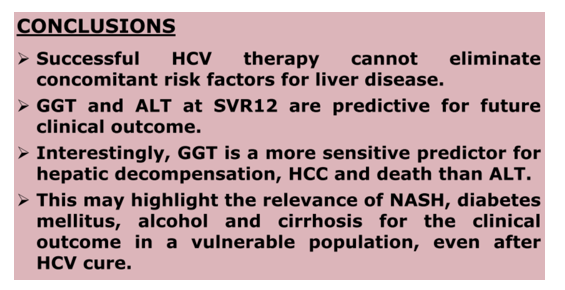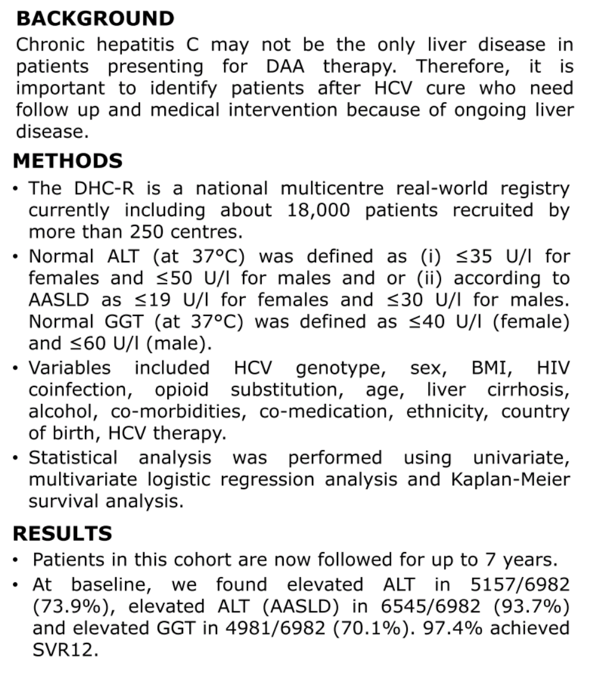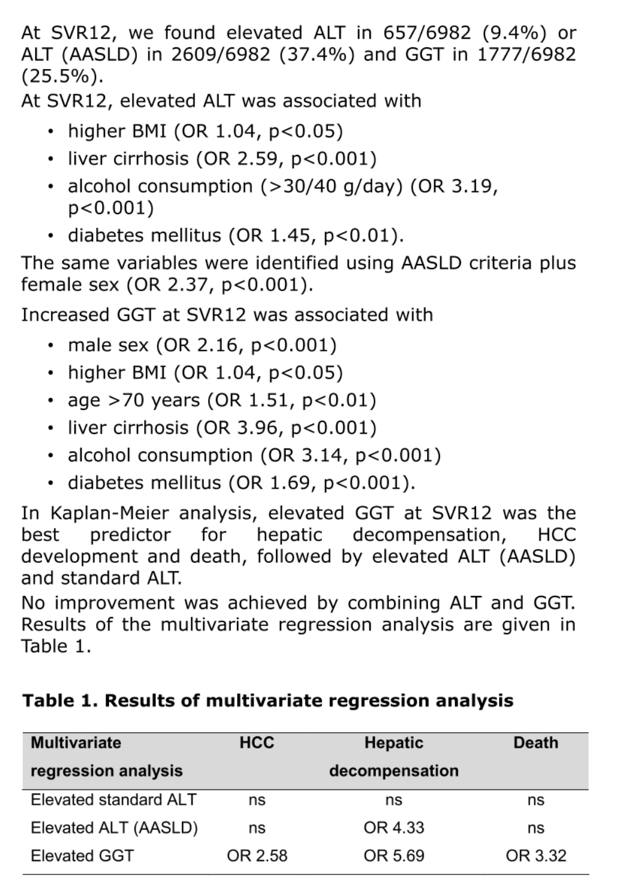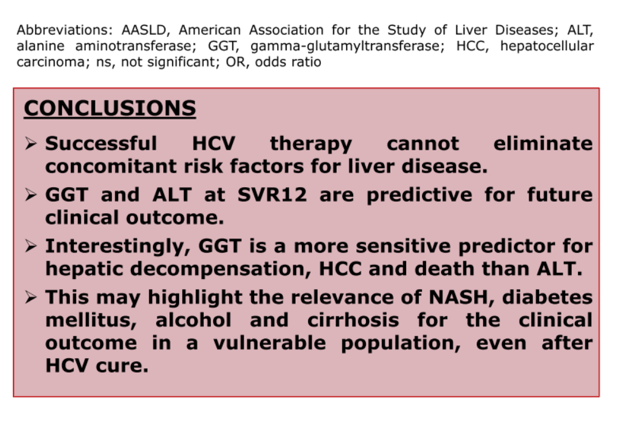 |
 |
 |
| |
IDENTIFYING PERSISTING LIVER DISEASE AND LIVER ASSOCIATED MORBIDITY AND MORTALITY AFTER VIRAL CURE OF HCV - DATA FROM THE GERMAN HEPATITIS C-REGISTRY (DHC-R)
|
| |
| |

A gamma-glutamyl transferase (GGT) test measures the amount of GGT in the blood. GGT is an enzyme found throughout the body, but it is mostly found in the liver. When the liver is damaged, GGT may leak into the bloodstream. High levels of GGT in the blood may be a sign of liver disease or damage to the bile ducts. Bile ducts are tubes that carry bile in and out of the liver. Bile is a fluid made by the liver. It is important for digestion.
AASLD 2021 Nov 12-15
Stefan Mauss1, Hartwig Klinker2, Klaus H.W. Boeker3, Uta Merle4, Ralph Link5, Peter Buggisch6, Dietrich Hueppe7, Markus Cornberg8, Christoph Sarrazin9,10, Heiner Wedemeyer8,11, Thomas Berg12, Frank Tacke13 and German Hepatitis C-Registry14, (1)Center for HIV and Hepatogastroenterology,(2)University Hospital Würzburg, (3)Leberpraxis Hannover,(4)University Hospital Heidelberg, (5)Mvz-Offenburg Gmbh /St. Josefs-Klinik, (6)Ifi-Institute for Interdisciplinary Medicine,(7)Gastroenterologische Gemeinschaftspraxis Herne, Herne, Germany, (8)Department of Gastroenterology, Hepatology and Endocrinology, Hannover Medical School, Hannover, Germany, (9)St. Josefs-Hospital, Wiesbaden, Germany,(10)Goethe-University Hospital, (11)Hannover Medical School (MHH), (12)Department of Medicine II - Division of Hepatology, Leipzig University Medical Centre, (13) Department of Hepatology and Gastroenterology, Charité Universitätsmedizin Berlin, (14)Leberstiftungs-Gmbh Deutschland
Background: Chronic hepatitis C may not be the only liver disease in patients presenting for DAA therapy. Therefore, it is important to identify patients after HCV cure who need follow up and medical intervention because of ongoing liver disease.
Methods: The DHC-R is a national multicentre real-world registry currently including about 17,900 patients recruited by more than 250 centres. Normal ALT (at 37°C) was defined as (i) ≤35 U/l for females and ≤50 U/l for males and or (ii) according to AASLD as ≤19 U/l for females and ≤30 U/l for males. Normal GGT (at 37°C) was defined as ≤40 U/l (female) and ≤60 U/l (male). Variables included HCV genotype, sex, BMI, HIV coinfection, opioid substitution, age, liver cirrhosis, alcohol, co-morbidities, co-medication, ethnicity, country of birth, HCV therapy. Statistical analysis was performed using univariate, multivariate logistic regression analysis and Kaplan-Meier survival analysis.
Results: Patients in this cohort are now followed for up to 7 years. At baseline, we found elevated ALT in 5157/6982 (73.9%), elevated ALT (AASLD) in 6545/6982 (93.7%) and elevated GGT in 4981/6982 (70.1%). 97.4% achieved SVR12. At SVR12, we found elevated ALT in 657/6982 (9.4%) or ALT (AASLD) in 2609/6982 (37.4%) and GGT in 1777/6982 (25.5%).
At SVR12, elevated ALT was associated with higher BMI (OR 1.04, p<0.05), liver cirrhosis (OR 2.59, p<0.001), alcohol consumption (>30/40 g/day) (OR 3.19, p<0.001) and diabetes mellitus (OR 1.45, p<0.01). The same variables were identified using AASLD criteria plus female sex (OR 2.37, p<0.001). Increased GGT at SVR12 was associated with male sex (OR 2.16, p<0.001), higher BMI (OR1.04, p<0.05), age >70 years (OR 1.51, p<0.01), liver cirrhosis (OR 3.96, p<0.001), alcohol consumption (OR 3.14, p<0.001) and diabetes mellitus (OR 1.69, p<0.001). In Kaplan-Meier analysis, elevated GGT at SVR12 was the best predictor for hepatic decompensation, HCC development and death, followed by elevated ALT (AASLD) and standard ALT. No improvement was achieved by combining ALT and GGT. Regression analysis see Figure.
Conclusion: Successful HCV therapy cannot eliminate concomitant risk factors for liver disease. GGT and ALT at SVR12 are predictive for future clinical outcome. Interestingly, GGT is a more sensitive predictor for hepatic decompensation, HCC and death than ALT. This may highlight the relevance of NASH, diabetes mellitus, alcohol and cirrhosis for the clinical outcome in a vulnerable population, even after HCV cure.



|
| |
|
 |
 |
|
|